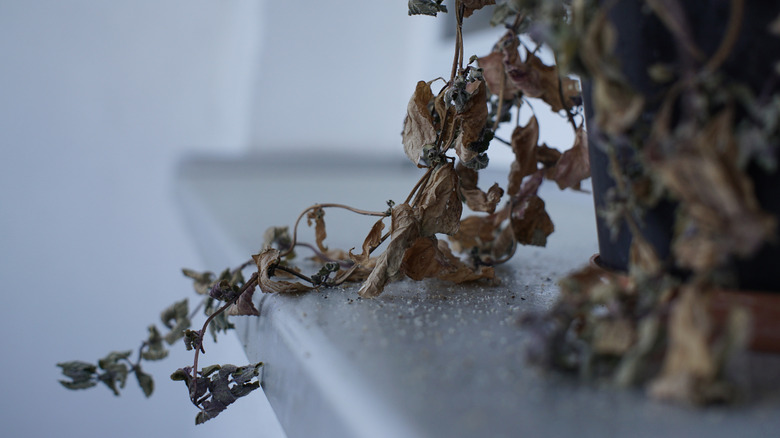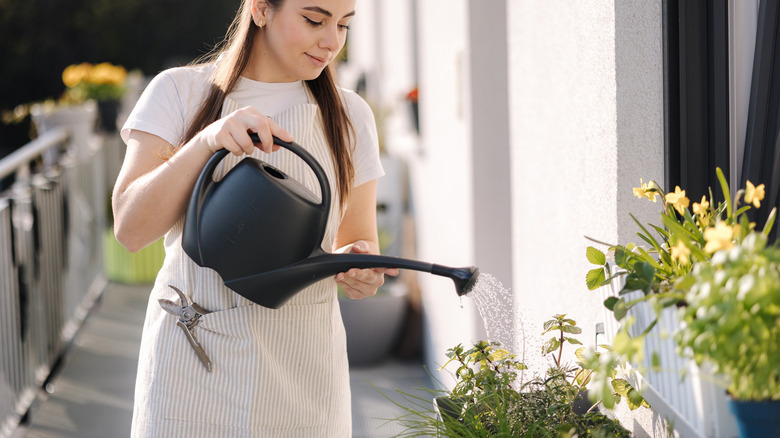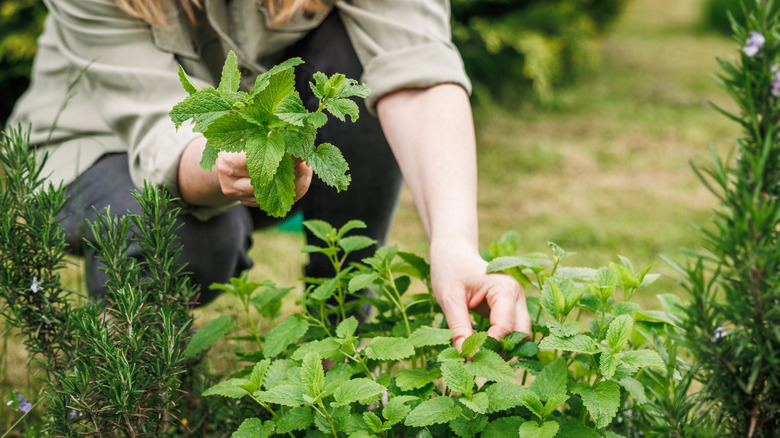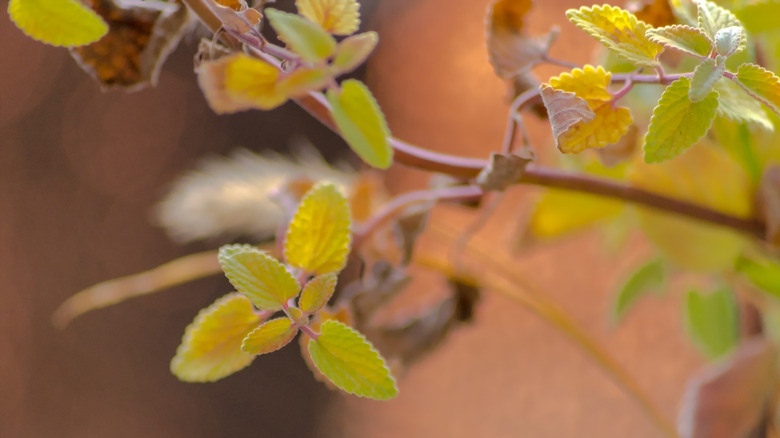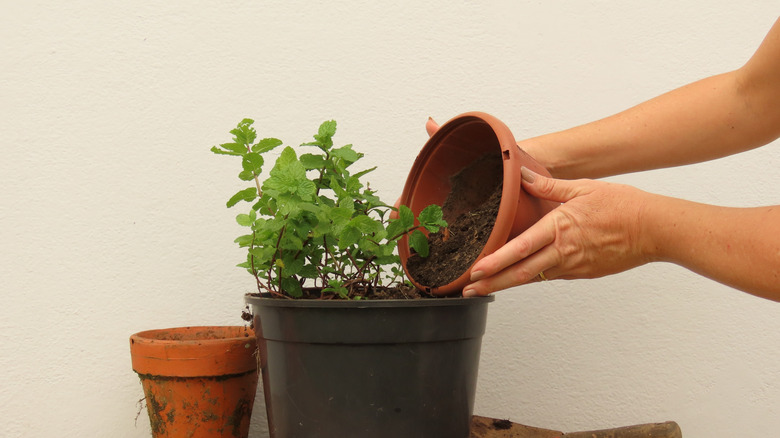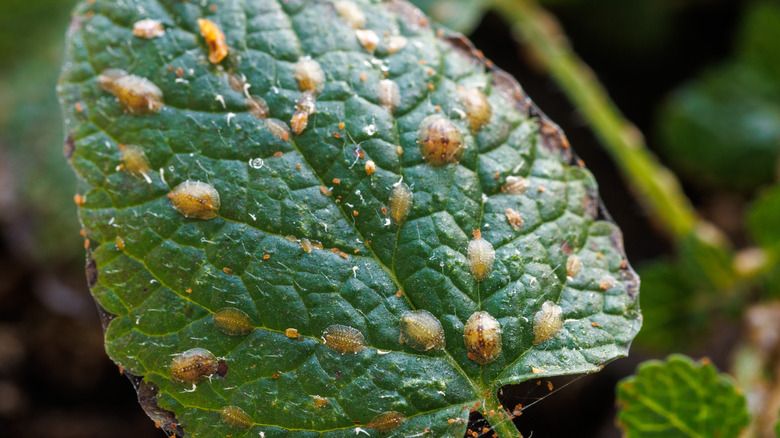Foolproof Ways To Bring Your Dying Mint Plants Back To Life
Mint has a reputation for being so easy to grow and more difficult to keep under control in your garden than it is to kill it. So, if your mint plant is withering, wilted, or otherwise looks like it's on the verge of death, you might be wondering where you went wrong and whether you can rescue it. Despite its tenacious reputation, there are some mistakes that could spell doom for your mint. Some of the biggest culprits include overwatering it, not watering enough, or harvesting too much of the fragrant herb at once.
Fortunately, the hardy plant can usually be brought back from the brink as long as you properly diagnose the problem and treat it. The main tricks for nursing your mint back to health include correcting watering issues, fixing soil problems, protecting it from heat or pests, and taking other steps to keep it healthy and comfortable.
But figuring out where to start comes down to knowing what's wrong with your mint right now. Whether it's indoors or outdoors, you should start by examining your plant to see what kind of problems or deficiencies its symptoms point to. Then, use one of the following foolproof tips to revive your garden mint and prevent it from becoming droopy or diseased again.
Start by checking for signs of watering issues
It's easy to get the watering requirements wrong for mint. While most other popular culinary herbs prefer drier conditions, mint actually likes moist soil. But it's also prone to diseases on both the roots and leaves. So if you are watering too much, not enough, or in the wrong way, you can end up with a sad-looking mint plant.
If you see signs of disease, like spots or yellowing on the leaves, the issue could actually be too much water. To fix it, find the cause. If it's in a pot, make sure that pot has holes for drainage. If it's in the ground, look at the soil. Is it soggy and compacted? You may need to carefully uproot the mint and add compost to the hole to improve drainage. Once the drainage issue is fixed, don't water again until the soil feels just slightly moist to the touch. When you do water, apply it to the soil around the base of the plant and avoid splashing the leaves and stems.
If the leaves are wilting and the soil looks dry, the problem is probably a lack of water. A good, deep watering should be enough to have your mint perking back up again. While it doesn't need to be watered daily, check the soil regularly and water often enough that the soil never dries out completely between waterings.
Make sure you're not harvesting too much
Harvesting mint regularly is important as it encourages the herb to put out foliage rather than flowers (which impacts flavor). It's also a good way to control the aggressive grower, as you can focus on harvesting sections that are growing beyond where you want the mint to grow. However, over-pruning is one of the biggest mistakes to avoid when growing a kitchen herb garden.
As a general rule, you should never harvest more than a third of an herb's growth at one time. You should also leave at least 4 to 6 inches of any given stem on the plant so that it can produce new growth. Then, you should stop harvesting altogether about a month before your first frost date. If you harvest too late in the season, the new growth that emerges after cutting won't have time to harden off before winter, leaving it vulnerable to frost damage.
If you've harvested a lot of mint lately, give your plant a break. Keep it well-watered and let it put on a good amount of new growth before you harvest again.
Protect it from excess sun or heat
For gardeners in hot climates, heat damage is a serious threat. If it's hot out and your mint has rolling or cupping leaves, it could be heat stress. Another sign is wilting leaves during the heat of the day that seem to revive when temperatures drop later in the evening. The fix: mulch around your mint if you haven't already. This will protect the roots from the excess heat. If you do see wilting, water deeply right away. If not, stick to your usual schedule but do it early in the morning before the heat sets in.
If your mint is in a container, move it to a spot that gets afternoon shade. If moving isn't an option, you can try putting up a large umbrella or other makeshift screen to shade your mint during the hottest part of the day. Just make sure to take it down at night or early in the morning so it can still get some direct sunlight each day.
While it's recovering from heat stress, avoid adding fertilizer or using pesticides. Fertilizers can trigger new growth that will be too tender to withstand the heat, while pesticides can damage the plants if applied when temperatures are too high. Even if you're dealing with soil problems or pests, treat the heat stress first. In the meantime, you can apply compost under the mulch instead of fertilizer. For pests, gently wipe them away with a cloth or hose them off when you water your mint.
Diagnose and fix soil problems
While mint can survive just about any conditions, the best place to plant mint is in moist soil with plenty of nutrient-rich organic matter. But if your mint is growing in containers or poor garden soil, it's easy for the conditions to get thrown out of balance. Too much fertilizer can cause your plant to grow too fast. All that rapid new growth will be weak and tender, inviting pests and disease. It also won't have as much of the oils that give mint its strong flavor.
If your plant looks like it has lots of young growth, but it's a little floppy or starting to yellow, you may have over-fertilized. If your mint is in a pot or container garden, you can either re-pot it with fresh potting soil or try leaching the excess fertilizer by watering the plant deeply. You want to add enough water that it's pouring out of the bottom drainage holes. Do this again one more time, a few hours later or the next day. But don't repeat it more than twice in a row, or you could end up overwatering.
Not enough nutrients can be just as harmful. Signs of nutrient deficiencies include lack of new growth, dead or dying leaves, and yellowing (but not necessarily wilting) leaves. To fix this without over-fertilizing, try adding a small amount of slow-release organic fertilizer. Alternatively, spread some compost around the plant and let it gradually work its way into the soil.
Monitor for and treat pests and diseases
If your mint looks like it's dying and you see signs of pests or disease, you need to treat the infestation and the underlying problem that allowed the pests or disease to spread. If you see aphids or other pests, you may be able to simply hose them off. If they've taken over an entire plant, you might need to rip out that plant before the pests spread to the rest of your garden. If using insecticides, make sure to choose one that targets the species of pest you're dealing with.
For fungal diseases, your best bet is to remove all parts of the plant that show signs of infection. Then, check your mint daily for early signs of disease on other leaves and stems. Pinch off any leaves with small white dots or spots that look like the leaf or stem is soaked in water.
In most cases, these infections or infestations are able to flourish because the soil or leaves are too wet, not getting enough sun, or not getting enough airflow. So, while treating the pest or disease now, also correct any environmental issues. When watering, make sure to water the soil around your mint and avoid getting the leaves wet. If your mint is in a crowded container with other herbs, trim everything back so that there is space for airflow between plants. If the pests showed up shortly after you applied a big dose of fertilizer, skip the fertilizer for the rest of the season.
